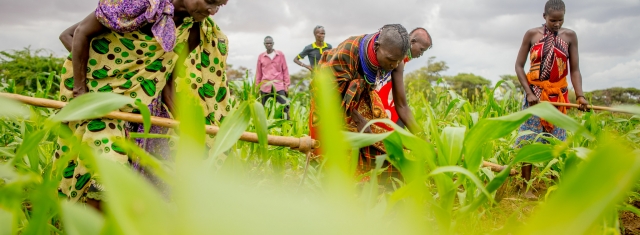News
African dependence on rain-fed agriculture, a fatality?
African dependence

Turning the Desert Green: Building Resilience in E (Source: USAID in Africa)
USPA NEWS -
With a very rapidly growing agricultural sector, Africa also needs to develop a very specific strategy for water management. What was formerly seen as a workaround solution, rain, may prove to be the motherlode, if newly designed solutions are applied in a different approach.
With a very rapidly growing agricultural sector, Africa also needs to develop a very specific strategy for water management. What was formerly seen as a workaround solution, rain, may prove to be the motherlode, if newly designed solutions are applied in a different approach.
Contrary to popular belief, Africa does not suffer from lack of water. The continent receives over 3 feet of water, on average, every year. But stretched over 5000 miles, both ways, and encompassing 14 different climates, local water precipitations vary a hundred-fold, between the desertic regions of the Sahara, and the monsoon areas, leaving some populations with dangerous excess, while exposing others to difficult droughts. Often the only transfers of water between countries are usually performed naturally by rivers. Soiled water then becomes unsuitable for drinking and agricultural purposes and generates a string of downstream problems. Rain water, however, is, somewhat cleaner.
Rainwater has been seen, until now, as a “least-worst“ solution, but that may be changing. The problem isn´t with the technology, which has been mature for some time, due to its simplicity. Because rainfall is both unpredictable and scattered, it was deemed at best a partial answer to African water needs. Nearly 30 countries on the continent are in high-water-stress areas and could simply not wait for the next shower to sustain its population, agriculture and industry. Climatologist Menghestab Haile says: “The most affected are rural households whose livelihood is heavily dependent on traditional rainfed agriculture. Rainfall plays a major role in determining agricultural production and hence the economic and social wellbeing of rural communities. The rainfall pattern in sub-Saharan Africa is influenced by large-scale intra-seasonal and inter-annual climate variability including occasional El Niño events in the tropical Pacific resulting in frequent extreme weather event such as droughts and floods that reduce agricultural outputs resulting in severe food shortages.“ But what if the solution were not in the rain from above, but the rain from below?
The absence of an integrated continental water network limit options considerably. Large water treatment installations provide excessive outputs for the local water networks and are far too costly for small communities to afford. But attention is turning, in these times of widespread environmental reflection and exploration, towards harnessing natural forces. Rivers, including underground sections, already provide the distribution network that countries need. With the exception of the arid areas (which are home to a very small minority of the African population), most countries on the continent have underground rivers, which present contamination levels inferior to surface levels (as the water has already been partially filtered by the soil it went through). Less liable to pollution, these underground rivers are already mapped for their most parts. This implies, that, should proper treatment stations be available, rain would not only hydrate the areas where it falls, but then naturally distribute all the areas downstream.
The treatment of the water is the delicate phase, in harvesting river-channeled rainwater. Most African countries have water treatment stations in large cities, and even those are often overwhelmed. "Nairobi's water system was planned for a population of about half a million people, but it now has more than 4 million people," said John Ponsonby, associate director of infrastructure for Deloitte. "Part of the problem with water is you need to think many years in advance ... You have to be able to cope with changes in climate." In the meantime, catchment systems can optimize water recuperation at a satisfactory level. The NGO Water Project Inc. says: “Also called rain harvesting, these simple systems connect downspouts (gutters) to a central water tank capable of holding about 100,000 liters of water or more. Often, in African countries, the issue is not that it never rains, but rather that when it does, most of the runoff is lost. These water systems make the best use of what little rain there is.“
As for water treatment, new mobile units, such as those built by Veolia in its “Ambitions for Africa“ program, provide mobile, off-grid solutions best suited for these situations. They can be moved to any drilling point, extract and 2500 cubic meters a day, and run on thermal or solar power. “These systems can then be used to provide drinking water but also and above all they are an essential tool to continue the growth of the agricultural industry, which is undeniably one of the driving forces of the African economy“, the CEO of Veolia Water, Patrick Couzinet, explains.
Whichever options are chosen, the matter will have to be quickly addressed, and all options should be examined, in the urgency of the matter, in addition to the commercial opportunity. Xavier de Savignac assesses that “By the middle of this century, the African population will probably have increased from 1 to 2 billion. The average income per capita, at present less than 10 percent of the corresponding income in industrial countries, should have increased at least fourfold (assuming a rate of 3 to 4 percent per year).“
Liability for this article lies with the author, who also holds the copyright. Editorial content from USPA may be quoted on other websites as long as the quote comprises no more than 5% of the entire text, is marked as such and the source is named (via hyperlink).





